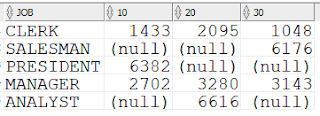-- DATA SETUP --
create table emp_t(empno number,
ename varchar2(100),
mgr number,
sal number);
Insert into EMP_T (EMPNO,ENAME,MGR,SAL) values (7839,'KING',null,1000);
Insert into EMP_T (EMPNO,ENAME,MGR,SAL) values (7698,'BLAKE',7839,700);
Insert into EMP_T (EMPNO,ENAME,MGR,SAL) values (7782,'CLARK',7839,500);
Insert into EMP_T (EMPNO,ENAME,MGR,SAL) values (7566,'JONES',7839,800);
Insert into EMP_T (EMPNO,ENAME,MGR,SAL) values (7788,'SCOTT',7566,200);
Insert into EMP_T (EMPNO,ENAME,MGR,SAL) values (7902,'FORD',7566,100);
Insert into EMP_T (EMPNO,ENAME,MGR,SAL) values (7369,'SMITH',7902,75);
Insert into EMP_T (EMPNO,ENAME,MGR,SAL) values (7499,'ALLEN',7698,100);
Insert into EMP_T (EMPNO,ENAME,MGR,SAL) values (7521,'WARD',7698,200);
Insert into EMP_T (EMPNO,ENAME,MGR,SAL) values (7654,'MARTIN',7698,150);
Insert into EMP_T (EMPNO,ENAME,MGR,SAL) values (7844,'TURNER',7698,150);
Insert into EMP_T (EMPNO,ENAME,MGR,SAL) values (7876,'ADAMS',7788,50);
Insert into EMP_T (EMPNO,ENAME,MGR,SAL) values (7900,'JAMES',7698,100);
Insert into EMP_T (EMPNO,ENAME,MGR,SAL) values (7934,'MILLER',7782,300);
commit;
-- Query 1 --
select sum(sal)
from EMP_T
start with ENAME = 'FORD'
connect by PRIOR empno=mgr;
select EMPNO, ENAME, MGR, SAL,(select sum(sal)
from EMP_T
start with ENAME = a.ENAME
connect by PRIOR empno=mgr) group_sal
from emp_t a;
-- Query 2 --
CREATE OR REPLACE FUNCTION get_group_sal (
pin_ename VARCHAR
) RETURN NUMBER AS
lv_grp_sal NUMBER;
BEGIN
SELECT SUM(sal)
INTO lv_grp_sal
FROM emp_t
START WITH ename = pin_ename
CONNECT BY PRIOR empno = mgr;
RETURN lv_grp_sal;
END;
/
select EMPNO, ENAME, MGR, SAL,get_group_sal(a.ename) group_sal
from emp_t a;
-- Query 3 --
with FUNCTION fn_group_sal (
pin_ename VARCHAR
) RETURN NUMBER AS
lv_grp_sal NUMBER;
BEGIN
SELECT SUM(sal)
INTO lv_grp_sal
FROM emp_t
START WITH ename = pin_ename
CONNECT BY PRIOR empno = mgr;
RETURN lv_grp_sal;
END;
select EMPNO, ENAME, MGR, SAL,fn_group_sal(ename) group_sal
from emp_t a;


